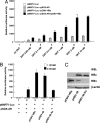Hepatitis B virus X protein enhances androgen receptor-responsive gene expression depending on androgen level
- PMID: 17259306
- PMCID: PMC1783528
- DOI: 10.1073/pnas.0609498104
Hepatitis B virus X protein enhances androgen receptor-responsive gene expression depending on androgen level
Abstract
Persistent hepatitis B virus (HBV) infection is a major risk of hepatocellular carcinoma (HCC). One intriguing feature of HBV-related HCC is the male predominance, with a male to female ratio of 5-7:1. This dominance has been attributed to the elevated androgen level and the enhanced androgen receptor (AR)-mediated activity in the host. How HBV infection and AR signaling modulate HCC is unknown. We investigated whether the HBV nonstructural protein, X protein (HBx) could cooperate with the AR signaling pathway to enhance carcinogenesis. We found that HBx increased the anchorage-independent colony-formation potency of AR in a nontransformed mouse hepatocyte cell line. We also found that HBx functioned as a positive transcriptional coregulator to increase AR-mediated transcriptional activity. This transcription enhancement was increased in the presence of androgen in a concentration-responsive manner, thus explaining a more prominent effect in males. HBx did not physically associate with ligand-bound AR in the nucleus, and it likely augmented AR activity by increasing the phosphorylation of AR through HBx-mediated activation of the c-Src kinase signaling pathway. Our study documents HBx as a previously undescribed class of noncellular positive coregulators for AR. The results reveal a mechanism for the vulnerability of males to microbial infections and the subsequent development of cancer.
Conflict of interest statement
The authors declare no conflict of interest.
Figures





Similar articles
-
[Correlation between androgen receptor expression and hepatitis B virus X protein and its clinical significance in hepatocellular carcinoma].Zhonghua Zhong Liu Za Zhi. 2013 Apr;35(4):282-7. doi: 10.3760/cma.j.issn.0253-3766.2013.04.009. Zhonghua Zhong Liu Za Zhi. 2013. PMID: 23985257 Chinese.
-
Hepatitis B virus X protein enhances the transcriptional activity of the androgen receptor through c-Src and glycogen synthase kinase-3beta kinase pathways.Hepatology. 2009 May;49(5):1515-24. doi: 10.1002/hep.22833. Hepatology. 2009. PMID: 19205031
-
Sorafenib Action in Hepatitis B Virus X-Activated Oncogenic Androgen Pathway in Liver through SHP-1.J Natl Cancer Inst. 2015 Jul 23;107(10):djv190. doi: 10.1093/jnci/djv190. Print 2015 Oct. J Natl Cancer Inst. 2015. PMID: 26206949
-
Effects of hepatitis B virus X protein on the development of liver cancer.J Lab Clin Med. 2006 Feb;147(2):58-66. doi: 10.1016/j.lab.2005.10.003. J Lab Clin Med. 2006. PMID: 16459163 Review.
-
Mechanisms of prostate cancer cell survival after inhibition of AR expression.J Cell Biochem. 2009 Feb 15;106(3):363-71. doi: 10.1002/jcb.22022. J Cell Biochem. 2009. PMID: 19115258 Review.
Cited by
-
Hepatitis B virus, a sex hormone-responsive virus.Gastroenterology. 2012 Apr;142(4):696-9. doi: 10.1053/j.gastro.2012.02.036. Epub 2012 Feb 24. Gastroenterology. 2012. PMID: 22370219 Free PMC article. No abstract available.
-
Cell cycle-related kinase is a direct androgen receptor-regulated gene that drives β-catenin/T cell factor-dependent hepatocarcinogenesis.J Clin Invest. 2011 Aug;121(8):3159-75. doi: 10.1172/JCI45967. Epub 2011 Jul 11. J Clin Invest. 2011. PMID: 21747169 Free PMC article.
-
Hepatocellular Carcinoma Due to Nonalcoholic Fatty Liver Disease: Current Concepts and Future Challenges.J Hepatocell Carcinoma. 2022 Jun 1;9:477-496. doi: 10.2147/JHC.S344559. eCollection 2022. J Hepatocell Carcinoma. 2022. PMID: 35673598 Free PMC article. Review.
-
Androgen receptor in hepatocarcinogenesis: Recent developments and perspectives.Oncol Lett. 2015 May;9(5):1983-1988. doi: 10.3892/ol.2015.3025. Epub 2015 Mar 10. Oncol Lett. 2015. PMID: 26136999 Free PMC article.
-
Hepatitis B- and hepatitis C-related hepatocellular carcinomas in the United States: similarities and differences.Hepat Mon. 2012 Oct;12(10 HCC):e7635. doi: 10.5812/hepatmon.7635. Epub 2012 Oct 25. Hepat Mon. 2012. PMID: 23233865 Free PMC article.
References
Publication types
MeSH terms
Substances
LinkOut - more resources
Full Text Sources
Molecular Biology Databases
Research Materials
Miscellaneous

